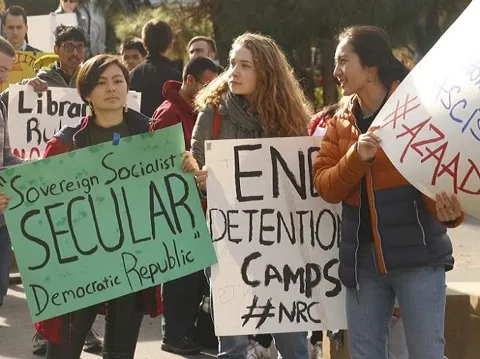Table of Contents
Recently, the Indian government passed the Citizenship Amendment Act (CAA), which provides fast-track citizenship to religiously persecuted minorities from Afghanistan, Pakistan, and Bangladesh belonging to six groups: Hindus, Sikhs, Buddhists, Jains, Parsis, and Christians. The bill has led to violent protests and international condemnation because it excludes Muslims.
However, I believe that the CAA is legitimate. Furthermore, protests against it have embraced alarmism instead of considering the CAA within its historical context.
At Stanford, students circulated this letter condemning the CAA and held a rally expressing solidarity with protestors. What prompted the campus activist machine to respond with such conviction?
Unfortunately, it seems to be an embrace of misinformation and virtue signaling. Both the open letter and promotional materials for the rally ignore the bill’s history and make several inaccurate claims.
First, the open letter argues that the CAA constitutes “a deep betrayal of the founding ideals of the Republic of India as envisaged by Mahatma Gandhi, Dr. B.R. Ambedkar, and Pt. Jawaharlal Nehru.'' However, all three of these leaders supported CAA-style policies during their careers.
Nehru and Ambedkar both voted for a Congress Working Committee resolution saying that the Indian government “is bound to afford full [citizenship] protection to all those non-Muslims from Pakistan who have crossed the border and come over to India.” Moreover, Gandhi declared the following during a public prayer sesion in 1947, “Hindus and Sikhs staying in Pakistan can come to India by all means.” Like in the CAA, what’s missing from Gandhi, Nehru, and Amebdkar’s statements? Any mention of religiously persecuted Muslims.
These are the same secular heroes the letter accuses the CAA of betraying. How could they have advanced such a discriminatory message? Clearly, the bill’s context is much more complex than a group of college protestors would let on, or Gandhi, Nehru, and Ambedkar were anti-Muslim nationalists!
To understand the actual purpose of the CAA, it’s necessary to address why a fast-track path was initially proposed. Since the Indian Partition in 1947, the six groups the CAA includes have faced all kinds of brutal repression at the hands of governments in Afghanistan, Pakistan, and Bangladesh. As a result, members of these groups have been forced to flee their home countries, each of which specifies Islam as the state religion.
In the case of Hindus, stories of destroyed temples, rape, and murder abound within Pakistani and Bangladeshi borders. Christians are also targeted. In 2016, Pakistan had 76 Christian murders, the highest in the world. That year, Pakistan also led the world in attacks on churches, with over 600. In Afghanistan, thousands of Sikh families have been forced to abandon their homes since 2009. Stories like this are all too common and continue to this day. Frankly, it’s disappointing that the campus narrative has glossed over these horrific details.
Additionally, the letter claims that the CAA “excludes Muslim asylum seekers from its ambit altogether”. This is simply false. Under Indian law, citizenship can be granted to any individual, irrespective of religion. The CAA doesn’t modify this existing policy, meaning that Muslims from any nation, Muslim-majority or otherwise, will continue to have asylum and citizenship rights via the traditional pathway. This dispels one of the biggest misconceptions circulating on social media.
Another criticism levied by the Stanford letter is that the CAA ignores religiously persecuted Muslims such as Ahmadis. For years, Islamic nations such as Pakistan and Bangladesh have persecuted Ahmadis by refusing to consider them Muslim. Protestors argue that groups like Ahmadis should also be afforded CAA protection.
But following a landmark ruling in December 1970, Indian law began recognizing Ahmadis as Muslim in order to grant them the religious legitimacy they had previously been denied. Due to this classification, Ahmadis aren’t considered religious minorities because their countries of origin (Pakistan and Bangladesh) are Islamic theocracies by law. This legal precedent is why groups like the Ahmadis are outside the scope of the CAA. Again, it is important to stress that for groups like the Ahmadis, Indian immigration law already offers an existing citizenship pathway which the CAA does nothing to limit or modify.
Practical considerations also play a role. Offering Muslim refugees an accelerated path to citizenship may work in the future, but only if those who genuinely faced religious persecution can be identified. India contains an estimated 20 million illegal Muslim migrants, significantly more than members of the other six groups. Most entered India for economic and political reasons, not religious ones. Trying to figure out which claims are genuine is nearly impossible. I invite the Stanford protestors to solve this problem, but until they do, India has an unequivocal right to implement immigration policy that secures its border.
Most importantly, the CAA does not affect existing Indian citizens. Anti-CAA propaganda at Stanford has painted an apocalyptic picture of an India in which Muslims are relegated to second-tier status. This mischaracterizes the bill. The CAA does absolutely nothing to curtail the rights of any existing Indian citizen, Muslim or otherwise.
Ultimately, as a proud Indian-American, I admire India’s secular tradition and join the protesters in denouncing alleged acts of police brutality. However, the CAA does not erode Indian secularism. The accusation that it amounts to a religious citizenship test makes no sense given that traditional naturalization pathways remain open to Muslims.
Identity politics and misinformation are serious threats to any democracy, and I believe that public debate over the CAA is guilty of both. When I see claims like the CAA “lays the groundwork for Muslim-only detention camps” in promotional material for the Stanford rally, I worry about the extent to which sensationalization has shaped campus activism.
Instead of echoing the same fear-mongering and alarmist arguments that have been circulating on social media, I would urge the authors of the letter and rally organizers to delve deeper into the historical circumstances surrounding the legislation and judge the CAA alongside the precedents set by existing Indian immigration policy.
Photo credit: Michael Espinosa









